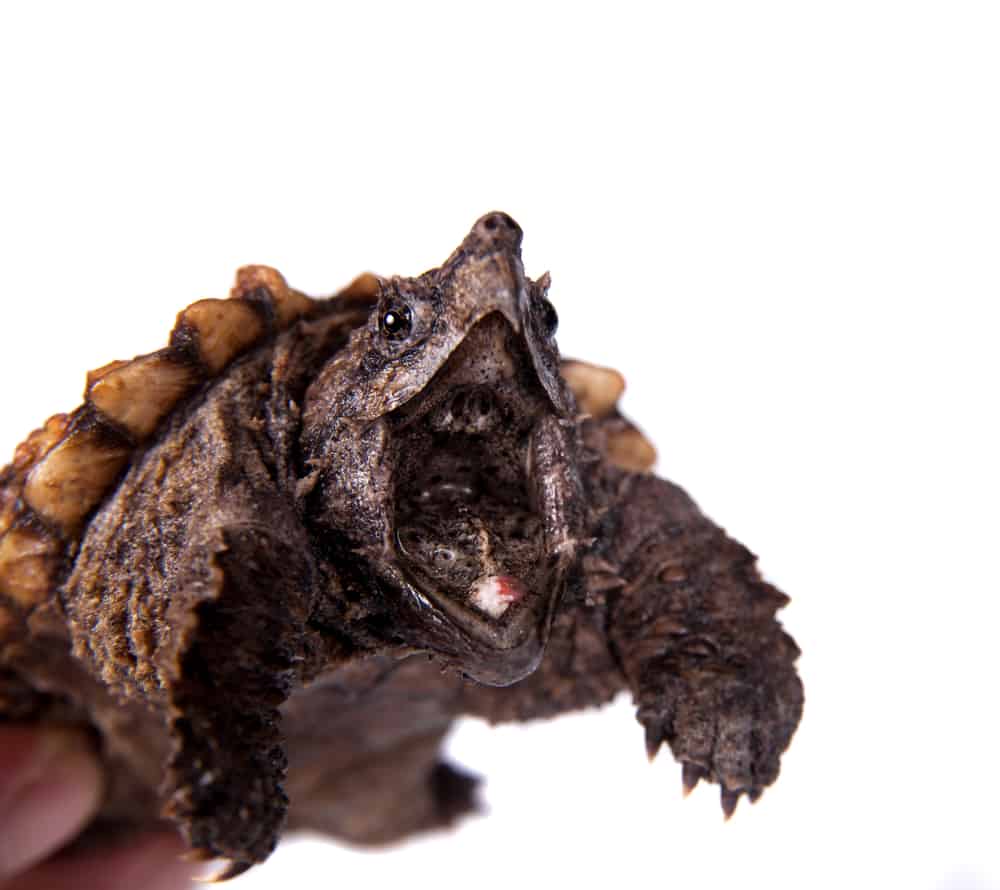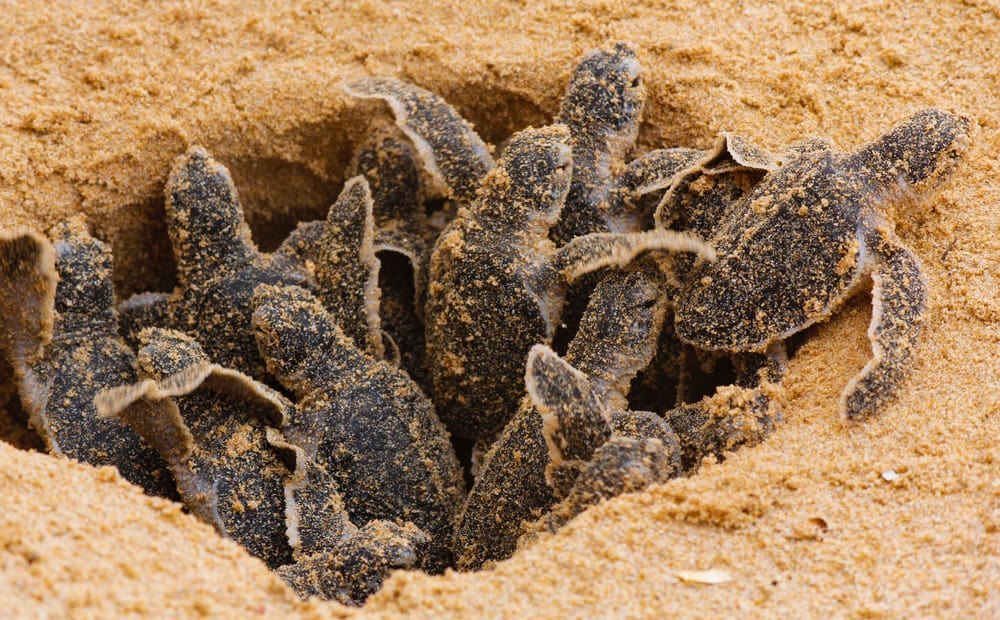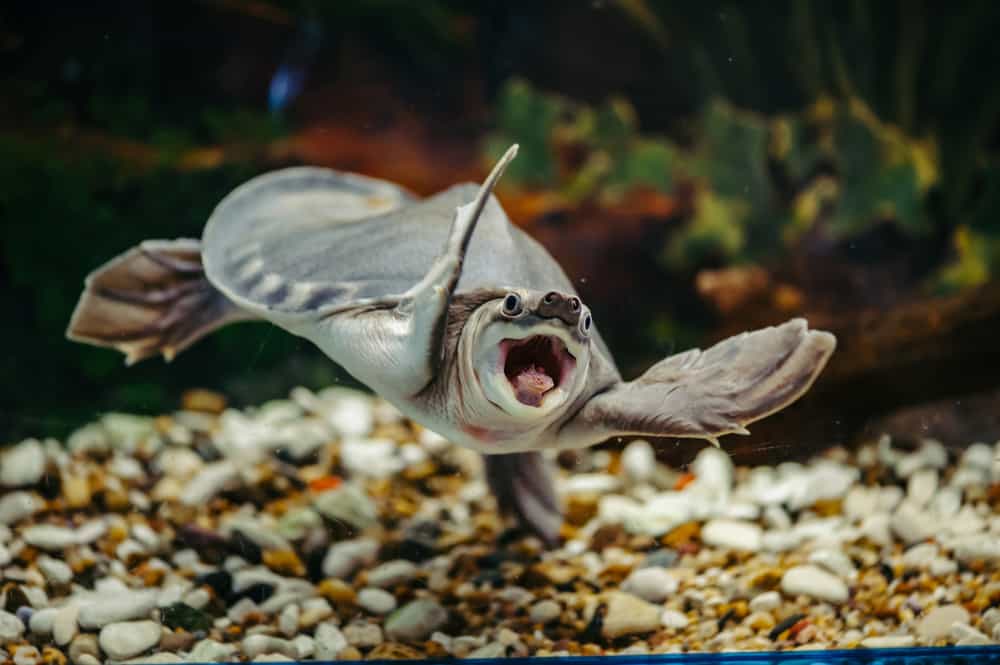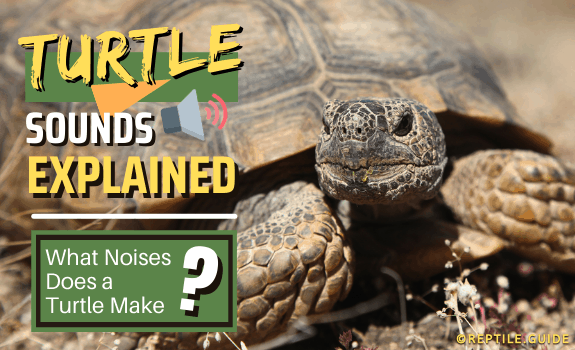Turtles may not seem like it, but they’re capable of making a surprising variety of noises! Learn all about turtle sounds today (and listen to some!)
Unlike the singing amphibians that turtles share their pond with, turtles aren’t known for being particularly vocal.
Fun Fact: Musical talent isn’t the only difference between turtles and frogs! Do you want to learn more about the differences between amphibians and turtles (opens in new tab)?
Recently, scientists have published research that indicates just how noisy turtles can be. We’re going to dive deep and learn how and why turtles make sounds. You’ll even get to hear many of the noises for yourself!
In This Article
Do Turtles Make Sounds?
- Yes, turtles make sounds!
- Hissing is the most common turtle noise that people hear.
- Most turtle sounds are too low-pitched for the human ear.
- Some turtle noises are audible, but we don’t notice them because they’re too quiet and short.
- Turtles create noises by expelling air from their lungs at varying intensities and speeds.
- A respiratory infection causes many audible turtle sounds. If you notice your pet turtle making more sounds than usual, make an appointment with your reptile veterinarian.
Do You Want to Hear Turtle Sounds?
Luckily, we’ve lined up a slew of videos and research containing turtle recordings.
Which Sounds Can a Turtle Make?
You may be surprised to learn that turtles make many different sounds.
Some of them we can hear easily. An angry turtle’s hiss is a sound most won’t forget.
Other turtle sounds are out of any human’s hearing range.
Children can hear some turtle noises that adults can’t detect.
Hissing
Turtles hiss by pushing air out of their lungs. Hissing tends to happen when they retract their body into their shell.
There isn’t much extra room in a turtle’s shell! The lungs must collapse for the whole body to fit. Subsequently, the air is expelled, creating a hissing sound. Imagine air escaping a hole in a tire.
Sometimes, the sound of a GIANT tortoise’s breathing can sound like a hiss. Turtles with a respiratory infection may also make a hissing noise when they struggle to breathe.
In the video below, you can see that the turtle hisses every time it retracts its head further into the shell.
Grunting
Grunting is similar to hissing. It’s usually caused by the same physical reaction of air escaping the lungs.
Grunts are deeper and shorter than hisses. They’re likely a result of allowing more air to escape at once.
This tortoise is grunting as it attempts to hide from the dog:
Crying
The sound of a turtle crying is usually caused by a respiratory infection. Excessive mucus in the airways creates narrow paths for airflow. Think about the way airflow sounds different when you whistle.
A turtle’s cries can also sound like little meows.
This video is an example of a sick red-eared slider (Trachemys scripta elegans) crying:
Roaring
Big-headed turtles (Platysternon megacephalum) are known to emit a roar-like sound when disturbed. This sound is likely another variation of a hiss. Their unique anatomy may help with their BIG noise.
Chirping
Some tortoises make a chirping or squeaking sound. An increase in breathing rate due to stress is likely the cause of this. Tortoise keepers have noticed that babies make this noise more often.
In this video, a tortoise chirps in response to a new environment. Turtles will make a similar noise when they’re excitedly eating.
Gurgling
Here, a private owner has recorded a video of their snapping turtle (Chelydra serpentina) emitting a low gurgling sound. According to the poster, this is how the turtle communicates that it’s hungry.
Singing
In 2005, naturalist Lang Elliott managed to catch a recording that supposedly features an adult male snapping turtle (Chelydra serpentina) vocalizing. The recording features a low, almost mournful song.
The same turtle now lives at the Lowry Park Zoo in Tampa, Florida. A display that plays the recording is situated outside of the enclosure.
Echolocation
The Arrau river turtle (Podocnemis expansa), also known as the giant South American river turtle, will be featured frequently. They are the most social and well-studied species of freshwater turtle when it comes to vocalizations.
Arrau river turtles grow to be up to 200 pounds and have a three-and-a-half foot carapace. They’re native to South America’s Amazon, Orinoco, and Essequibo basins. Their uniquely social behaviors include nesting, migrating, and basking in groups.
Scientists theorize that Arrau river turtles utilize a unique type of echolocation to navigate the muddy river bottoms. Biologists have only recently begun to study turtle vocalizations. Only time can tell what these mysterious creatures are capable of.
Famous Turtle Sounds
Most people don’t expect any noises to come from a turtle. When folks find out that turtles can sound scary or funny, it’s a real shocker! Here are some of the most well-known turtle noises.
Snapping Turtle Hiss

A large, adult snapping turtle. He is ready to hiss – and snap!
The snapping turtle (Chelydra serpentina and Macrochelys temminckii) is a large and intimidating animal. They’re well known for their willingness to bite when provoked. Their hiss is also loud and commands respect.
Snapping turtles hiss immediately after lunging with lightning-fast speed. The sound certainly adds to the dramatic effect! The sound of these behemoths snapping their jaws shut is also hard to forget.
Mating Noises

These large tortoises are almost certainly creating a ruckus while doing the deed.
The sound of a mating turtle is, perhaps, the most famous turtle sound of all.
Time and again, video footage of these animals’ private moments goes viral. It’s no surprise, either. The noises that mating turtles emit certainly give the impression of a happy turtle! They’re also much higher-pitched than you may expect.
Male turtles also ram their shell into the female’s shell as part of the mating ritual. The impact creates a loud “clacking” noise.
Interestingly enough, different tortoise species make other mating noises. Here is the sound from a male Aldabra giant tortoise (Aldabrachelys gigantea):
Red-footed tortoises (Chelonoidis carbonaria) are known for sounding like clucking chickens:
Russian tortoises (Testudo horsfieldii) have been the usual culprit in viral videos. Their soft, squeaky sounds are pretty comical.
If you can’t get over their adorable sounds, consider adopting a pet Russian tortoise. They make great pets!
Purpose of Turtle Vocalizations
Dogs bark for different reasons. People use language to communicate vastly different topics. Similarly, turtle noises have various purposes.
Illness
It’s important to stress that most turtles and tortoises don’t make audible noises regularly.
Often, any noise coming from a tortoise or, especially, a turtle indicates a severe respiratory infection.
Here are some common, safe noises you can expect to hear from your pet:
- Hissing in response to stress.
- Thunking or clacking their shell against hard surfaces, such as the terrarium wall.
- Mating noises during breeding or perceived breeding with another species or inanimate object.
If you notice your turtle making any other sound, we strongly advise you to make an appointment with your local reptile veterinarian. Get that little guy checked out!
There’s a chance that you happen to have a healthy, happy, vocal turtle. Your veterinarian will let you know. It’s still better to be safe than sorry.
Threat Display
The roar of a big-headed turtle (Platysternon megacephalum) is a definite threat. They use the sound to ward off would-be predators – including humans.
Contrary to popular belief, turtles don’t hiss to threaten or convey aggression. A hissing turtle is usually a scared turtle. They’re attempting to hide away in their shell, not chase and bite you!
On the other hand, snapping turtles (Chelydra serpentina and Macrochelys temminckii) hiss due to rapidly extending and retracting their neck to snap. While the hiss is not, itself, a threat, it is the direct result of this turtle’s threat display.
Territorial Disputes
Turtles that are engaging in territorial disputes may emit the same hissing noise. This sound is, once again, a byproduct of the animal’s movement and breathing pattern.
Turtles often engage in territorial disputes underwater. You won’t be able to hear any noises they make in these instances.
Eating
Some turtles and tortoises emit tiny squeaks, grunts, and sighs when they’re eating.
These noises are indicative of the turtle’s excitement! Air escapes the turtle’s lungs when it quickly moves its head to reach for a bite to eat.
Here’s a video of a box turtle (Terrapene sp.) grunting as it tries to capture an earthworm snack:
Large tortoises belch as a result of ingesting air with their food. A turtle’s belch sounds unique – there aren’t words to describe it!
You can hear a Galapagos tortoise (Chelonoidis niger) burping at 0:20 in this video:
If the air can’t come out the front, then it must escape the back! Tortoises are known to let loose and make unpleasant flatulence noises. If curiosity has the best of you, you can hear a tortoise fart at 0:10 in this video:
Mating
While it’s clear that turtles make loads of noise while they’re breeding, it’s not evident why they make those sounds.
Some enthusiasts theorize that it’s a result of them tensing their neck muscles and breathing harder from the physical exertion.
Another idea is that they vocalize as a display of dominance or convince and woo the female to allow the male to finish the job.
Nesting

Adult female sea turtles emit a series of grunts, pants, and sighs while laying eggs. Egg-laying is an exhausting process.
Consider the fact that a sea turtle’s body was not designed to move efficiently on land – let alone dig an entire nesting hole! It’s no surprise that these tired-out females vocalize through the laying process.
You can hear some of the Olive ridley sea turtle’s (Lepidochelys olivacea) nesting sounds after the 2:10 mark in this video.
Scientists used microphones to confirm that mother Arrau turtles (Podocnemis expansa) vocalize to coordinate nesting behaviors. This species typically nests as groups, in the exact location and at the same time. These groups of nesting females often number in the hundreds! This behavior helps to ensure the safety and survival of both the mothers and the babies.
Baby Communication

One of the most exciting aspects of turtle vocalization and communication involves hatchling (and even embryonic) turtles!
Hatchling and Embryonic Sea Turtles
In 2012, scientists monitored 12 leatherback sea turtle (Dermochelys coriacea) nests using a microphone. What they heard was astonishing! Biologists describe embryonic sounds as a series of pulses, harmonic sounds, and a mixture of the two.
You can listen to some of the sea turtle nest recordings here.
Scientists believe that the baby turtles used those sounds to synchronize hatching and increase their chances of survival.
There is safety in numbers! It’s easy for predators to wait around and consume babies one by one if they emerge individually. Statistically speaking, when hatchlings emerge in the dozens or even hundreds, a far higher percentage of them will make it to the water.
Synchronized hatching also encourages teamwork and, thus, less energy consumption when digging out of the nest.
Hatchling and embryo sea turtles’ vocalizations range from 119.2 Hz to 24,000 Hz. Theoretically, humans can hear up to 20,000 Hz. However, the natural sounds of the beach make it nearly impossible to hear baby sea turtles in a natural setting.
Baby turtles start vocalizing to each other as early as ten days before hatching.
Hatchling and Embryonic Arrau River Turtles
Hatchling Arrau river turtles (Podocnemis expansa) utilize the same form of embryonic communication to hatch in synchrony. Hatchlings emerge from their nests in the thousands on their important day.
Unlike sea turtles, Arrau river turtle hatchlings have more than each other for support.
Scientists have also observed hatchlings and mother Arrau turtles communicating with each other. Females follow the sounds emitted by hatchlings. Mothers even wait in the area, calling out to the babies once they hatch.
It appears these turtles also communicate to coordinate group migrations. This interaction is the first documented instance of maternal care in any turtle species.
Social Communication

The pig-nosed turtle (Carettochelys insculpta) is known to be a communal species. They frequently engage in social feeding, thermoregulating, and nesting. Scientists recorded captive and wild pig-nosed turtles emitting at least three different sound categories to communicate with each other.
Do Turtles Have Vocal Cords?
Previously, biologists believed that turtles do not have vocal cords. However, scientists located two elastic bands of fibrous tissue in the larynx of three tortoise species. They’re not quite identical to mammalian vocal cords. Still, these structures are capable of vibrating and creating sounds.
Do Pet Turtles Communicate With Their Owner?

The overall scientific consensus is that turtles don’t vocalize to communicate with their owner.
A turtle may hiss in response to its owner’s presence or movements. As we discussed, this sound is an involuntary result of a turtle retreating into its shell.
Some turtle keepers claim that their pet does make noises to communicate wants or moods. The gurgling snapping turtle video above is a perfect example of this possibility.
Turtle enthusiasts also believe that their pets can learn to recognize their names. All the more reason to pick the perfect name for your pet turtle!
Further Studies
For the longest time, biologists believed that turtles were not only mute – but also deaf! Herpetologist Clifford H. Pope said turtles and tortoises are “deaf as a post”. Scientists blindly believed this to be true since 1955.
Most of the research identifying turtle noises has been conducted in the past ten years. Far more studies need to be done to figure out the physical mechanisms and survival purposes of turtle sounds.
These discoveries also beg the question: how much does human noise pollution affect wild turtles? It’s well-documented that oil drilling, shipping, construction, and sonar have a detrimental effect on other marine wildlife. We can reasonably assume that these issues will have a similar impact on our turtle friends.
More Thrilling Turtle Tidbits
We’ve discussed the various sounds created by both turtles and tortoises. Did you know that there are some critical differences between them?
The sounds emitted by these mysterious creatures aren’t their only exciting feature. A turtle’s shell is peculiar, and they wouldn’t survive without it. Turtles are truly a neverending source of fascination.
